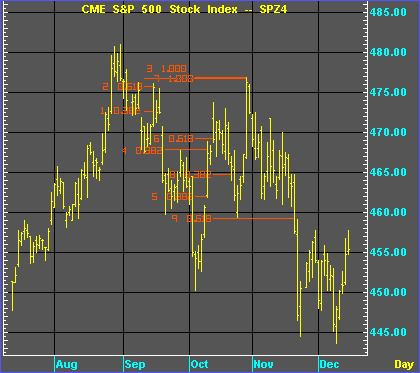TD Relative Retracement is a purely objective or mechanical method for displaying Fibonnaci retracement levels from designated lows and highs. These levels define areas of support or resistance. Retracement levels will appear as dashed lines until price penetrates them and is preceded by a qualified bar. Retracement levels are calculated as follows: from a low bar, refer to the last time a lower bar appeared and select the highest high between these two points and subtract the difference between those two points or from a high bar, refer to the last time a higher bar appeared and select the lowest low between these two points. By placing the cursor on these lows or highs and by selecting the desired Retracement settings, the levels are presented graphically.

The Relative Retracement study is an Aspen trendline draw function. Selecting TD Relative Retracement from the Trendline Functions menu prepares the trendline cursor to draw the Relative Retracement. Clicking on a bar in the chart defines an anchor point, or reference bar, for the retracement. The retracement lines can be modified or deleted in the same way as other Aspen trendlines, and their respective retracement levels are available in the cursor window.
A click is assumed to refer to the high, low, open, or close of a displayed bar; the software locates the nearest such point and uses it as the exact reference point. To be more precise, the software first finds the horizontally nearest bar column, then chooses the vertically closest reference point within that column. If multiple data items are on display, the one with the vertically closest reference point is chosen. (Formula data items are not eligible to be chosen.) Only high and low points are eligible.
For further information on Relative Retracement, please refer to Thomas R. DeMark, The New Science of Technical Analysis, New York: John Wiley & Sons, 1994, Chapter 2.
Topics:
Qualifying Relative Retracement
Parameters